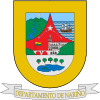Nariño Department
| Department of Nariño Departamento del Nariño | |||
|---|---|---|---|
| Department | |||
| |||
|
Motto: Desde el mar hasta el Galeras (Spanish: From the sea to the Galeras) | |||
| Anthem: Himno del Departamento de Nariño | |||
 | |||
| Coordinates: 01°10′N 77°16′W / 1.167°N 77.267°WCoordinates: 01°10′N 77°16′W / 1.167°N 77.267°W | |||
| Country |
| ||
| Region | Pacific Region/Andes Region | ||
| Established | August 6, 1904 | ||
| Capital | Pasto | ||
| Government | |||
| • Governor | Raúl Delgado Guerrero (Unity for a Better Nariño) | ||
| Area | |||
| • Total | 33,268 km2 (12,845 sq mi) | ||
| Area rank | 11th | ||
| Population (2013)[1] | |||
| • Total | 1,701,840 | ||
| • Rank | 8th | ||
| • Density | 51/km2 (130/sq mi) | ||
| Time zone | UTC-05 | ||
| ISO 3166 code | CO-NAR | ||
| Provinces | 3 | ||
| Municipalities | 62 | ||
| Website | www.gobernar.gov.co | ||
Nariño (Spanish pronunciation: [naˈɾiɲo]) is a department of Colombia named after Antonio Nariño. Its capital is San Juan de Pasto. It is in the west of the country, bordering Ecuador and the Pacific Ocean.
Nariño has a diverse geography and varied climate according to altitude: hot in the plains of the Pacific and cold in the mountains, where most of the population resides, a situation that is repeated in a north-south direction. Other important cities include Tumaco and Ipiales.
History
The territory was occupied during the Pre-columbian era by numerous Indian tribes, including Quillacingas, Awa, Tumas, and at some point some of these groups were part of the Inca Empire. The first conqueror who was entering the territory was Andagoya Pascual in 1522, who traveled from the Colombian Pacific coast and then used information obtained by Francisco Pizarro to organize the expedition that culminated in the conquest of Peru.
Juan de Ampudia and Pedro de Añazco first explored the mountainous part of the department, commissioned by Sebastian de Belalcazar in 1535, who then toured the territory in 1536 and reached Popayán and remained for some time before leaving for Spain.
Municipalities
- Albán
- Aldana
- Ancuya
- Arboleda
- Barbacoas
- Belén
- Buesaco
- Chachagüí
- Colón (Génova)
- Consaca
- Contadero
- Córdoba
- Cuaspud
- Cumbal
- Cumbitara
- El Charco
- El Peñol
- El Rosario
- El Tablón
- El Tambo
- Francisco Pizarro
- Funes
- Guachucal
- Guaitarilla
- Gualmatán
- Iles
- Imues
- Ipiales
- La Cruz
- La Florida
- La Llanada
- La Tola
- La Unión
- Leiva
- Linares
- Los Andes
- Magui
- Mallama
- Mosquera
- Nariño
- Olaya Herrera
- Ospina
- Pasto
- Policarpa
- Potosí
- Providencia
- Puerres
- Pupiales
- Ricaurte
- Roberto Payán
- Samaniego
- San Bernardo
- Sandona
- San Lorenzo
- San Pablo
- San Pedro de Cartago
- Santa Barbara
- Santacruz
- Sapuyes
- Taminango
- Tangua
- Tumaco
- Tuquerres
- Yacuanquer
References
External links
- (Spanish) Government of Narino official website
| Wikimedia Commons has media related to Cities and villages in the department of Nariño. |
| |||||||


